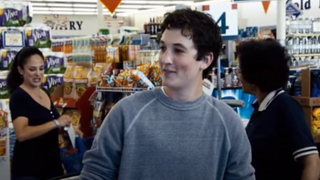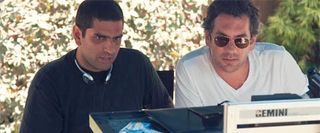Project X Director Nima Nourizadeh Talks The Future Of Found Footage

Here on Cinema Blend we’ve talked a lot about the future of found footage films. In fact, it was just a few weeks ago that Katey Rich and I sat down and had one of our great debates about the style, both seeing its potential and fearing what studios would do with the low-risk-high-reward nature of it all. But what do found footage filmmakers think about the prospects of the sub-genre? Luckily I recently had the chance to speak with Nima Nourizadeh, director of Project X, one-on-one to find out what he thinks.
Check out the interview below in which Nourizadeh not only talks about the future of found footage, but also what he thinks the advantages and disadvantages of the medium are, what he thinks his movie says about today’s youth culture and how he captured the various party footage not filmed by the main cameraman.
Watching this film and particularly the scene at the end, I did find myself wondering: is this movie at least partially based on that huge Australian party from a couple years back?
It’s funny you say that, because a few people have asked me that. No, I actually wasn’t inspired by or anything like that from that thing. I think it’s something that happens around the world. We hear about it more and more right now. I actually did a lot of research on it and you see this has happened everywhere. There was one that happened in the countryside in London where a girl, her parents were actually still at the party and it just got turned out and mass melee. Everyone is sort of using Twitter everyday now and Facebook…just the way for things to spread is just so common right now. I think there was even something on the news the other day about Facebook parties and how it’s become a real big thing right now and the cops are trying to hold it back. So no, the answer is no, but I’m sure people might see there being some sort of links. And if you look deeper you’ll see there’s a lot more.
Do you think this movie has a comment to make about today’s youth culture?
I think the way kids are today, again, they’re so used to seeing funny clips online. Yeah, I think kids are more readily sort of…all of this kind of material is more accessible right now and any kid can be a filmmaker right now by taking out their phone. I think it does reflect the youth today and I’m not saying what happens in the movie is what reflects kids today. I think that it’s an outrageous sort of comedy, it’s an R-rated comedy, so that’s the most important thing. I made it feel as real as possible, but in reality there are some things that happen that you just have to remember, “It’s a comedy and a movie.” [laughs]
To talk a bit more about that aspect of it, this film is a found footage film. From your perspective, what do you think are the advantages and disadvantages of using that as a medium to tell the story?
CINEMABLEND NEWSLETTER
Your Daily Blend of Entertainment News
Well, for me, first and foremost it meant we could try and be more real. It meant we could include more risqué things, more outrageous things. This approach meant that we had to show some of the realities of what kids do and I think that’s what makes this film feel very special and unique because there really hasn’t been a found footage party movie before. So I think for the kids it resonates with them much more, seeing material like this of our party and for me it was an amazing way of making a movie. It meant casting unknowns, working with kids who had never been in a movie before, that gave it a big sense of realism.

And what would you say the disadvantages are?
I think the disadvantages…to be honest, I actually didn’t face any disadvantage. I think it actually allowed me to shoot a lot more. We weren’t so rigid, laughter and spontaneity on the day. It just gave me more authentic material. To be honest, that was such a draw for me for making this movie was the approach, for it to feel documentary-style and that whole found footage thing was a major draw.
To talk about the format on a larger scale, we have seen some major films produced in the style, particularly the Paranormal Activity franchise. It feels like we’re at a point where it can go one of two ways: either it can be a way for independent filmmakers to make films much lower budget and still tell a story, while studios might see it as a way to really lower budgets and forgo story in order to just be able to make a quick buck. Where do you think the sub-genre is going?
It doesn’t feel like anyone’s gotten sick of it yet [laughs]. That could happen, but I think it’s really opened it up to lots of kids now. We know it works, it makes a lot of money and studios are on-board. And, like you said, for young filmmakers it might be a way to get a story out there that actually will really work. It could even drive your story. It would. It would be, “Oh, I have this idea, maybe I can do it this way for cheap.” It’s kind of taken over from the low-fi movie where it’s shot really badly…you know what I mean? Now you have an excuse for shooting really badly [laughs] and including really crappy looking footage. And it just makes it feel more real. I think it’s still a complicated way to tell a story and I think that’s getting more refined and it’s starting to feel like there’s rules to everything. I think it’s still got legs, and, again, there are so many different genres right now. It’s been strictly sort of the horror and now it can cross-over a bit more, a comedy, a drama maybe, an action movie – we’ve seen Chronicle, kids with superpowers. You know what I mean? It’s like a cool concept. I’m excited to see where it goes.
Throughout the film you have Dax’s camera doing most of the shooting, but throughout the film you also have footage from the various cell phones and flip cams of the people at the party as well as news crews and cop cars. Were those strategically placed or did you have the extras at the party shoot random stuff and put it all together in post?
It was a mix of the two, actually, because I always knew that as we progressed into the party it was always starting off with Dax’s camera and then as we get to the party and more people arrive, and as the police arrive and news cameras, we’re going to cut to the different perspectives of the party and include all of those bits of footage, which I thought was such a cool angle for this. So there were moments, for example, when someone is doing something that warrants someone filming it – like kids jumping off the roof – other kids will be filming that. So I thought those would be good moments, those are the strategic moments, when there was a stunt or something cool happening, where it’s plausible that some kid is going to film it. There were other moments, though, when I was like, “I just want some gems, I want things that aren’t planned. There’s no way for me to capture this myself.” So we handed out flips, we had Blackberrys, we had iPhones, we had all sorts. The guys, pulling all this material, hated me so much because there was hours and hours of unusable footage. Then there was always this one tiny piece that was like, “This is why these guys have these cameras.” They were filming themselves having fun. And we never wanted it to be strictly like, “This is a real movie, this is a real found footage film,” but when you have real material being shot by real people, it then kind of feels like it is. It is found footage. I hated spending 10 hours looking through bits of flip footage – people didn’t press stop, it’s like in their pockets. But yeah, it was great, man.

Eric Eisenberg is the Assistant Managing Editor at CinemaBlend. After graduating Boston University and earning a bachelor’s degree in journalism, he took a part-time job as a staff writer for CinemaBlend, and after six months was offered the opportunity to move to Los Angeles and take on a newly created West Coast Editor position. Over a decade later, he's continuing to advance his interests and expertise. In addition to conducting filmmaker interviews and contributing to the news and feature content of the site, Eric also oversees the Movie Reviews section, writes the the weekend box office report (published Sundays), and is the site's resident Stephen King expert. He has two King-related columns.
Most Popular







